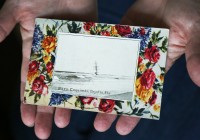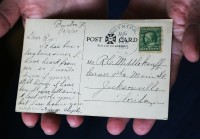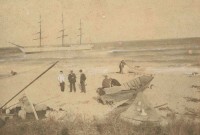 Janet DeVries, local historian and president of the Boynton Beach Historical Society in Palm Beach County, Florida, was browsing eBay on December 19th of last year when she came across a period postcard with a picture of a shipwreck well known to her. It was the wreck of the Norwegian barkentine Coquimbo which ran aground on a reef off Boynton Beach on January 31st, 1909. The postcard had been sent and was postmarked Boynton, August 9th, 1909. The message on the back read:
Janet DeVries, local historian and president of the Boynton Beach Historical Society in Palm Beach County, Florida, was browsing eBay on December 19th of last year when she came across a period postcard with a picture of a shipwreck well known to her. It was the wreck of the Norwegian barkentine Coquimbo which ran aground on a reef off Boynton Beach on January 31st, 1909. The postcard had been sent and was postmarked Boynton, August 9th, 1909. The message on the back read:
Boynton Fl. 8/8/09 – Dear Roger. It has ben (sic) a long time since I have heard from you so I wanto (sic) know if you are still living. I have ben (sic) all over hell since I last wrote you but I am home now carpentering. clyde
DeVries clicked the “buy it now” button and acquired the postcard for $10, a bargain considering what a rare testament to the town’s early history it is.
 The Coquimbo, an iron-hulled sailing ship with two square-rigged masts forward and schooner rigged mast aft, was carrying a hull full of pine lumber from Gulfport, Mississippi, to Buenos Aires, Argentina, when she hit the reef. The ship’s foghorns awakened guests at the oceanfront Boynton Hotel who hastened to the waterside to see what the commotion was about. The Coquimbo was perched on a sandbar, not sinking, but there were 15 crew members stranded on board, all Scandinavian, including Captain I. Clausen. Locals crossed the canal on a skiff and built a breeches buoy to rescue all 15 men.
The Coquimbo, an iron-hulled sailing ship with two square-rigged masts forward and schooner rigged mast aft, was carrying a hull full of pine lumber from Gulfport, Mississippi, to Buenos Aires, Argentina, when she hit the reef. The ship’s foghorns awakened guests at the oceanfront Boynton Hotel who hastened to the waterside to see what the commotion was about. The Coquimbo was perched on a sandbar, not sinking, but there were 15 crew members stranded on board, all Scandinavian, including Captain I. Clausen. Locals crossed the canal on a skiff and built a breeches buoy to rescue all 15 men.
The crew couldn’t afford to stay in the hotel so for the next two months they used the ship’s sails to make tents and camped out on the beach while they waited for the steam tugboat that would attempt to dislodge the ship. The tugboat spent days trying to budge the Coquimbo but it wouldn’t move an inch. It was destined to stay where it stood until the ocean waves tore the hull apart.
In 1909 southern Florida was still pioneer country, sparsely populated with limited supplies. The town of Boynton was only 11 years old at the time with a population of less than 700 souls. A ship full of long-leaf pine lumber with beams as long as thirty feet was a figurative gold mine for the settlers. Residents collected the wood that had washed up on the beach, stacking it in piles that reached as high as fifty feet. The lumber, along with the ship’s rigging, tackle, stores and provisions would be sold at auction (scroll down to see the notice) on March 30th, 1909, but the U.S. Marshall who oversaw the sale allowed the Boynton residents to mark the piles they had made and buy them for bargain prices at the auction.
 There aren’t many extant photographs of the Coquimbo. DeVries has been actively searching for pictures of the wreck for the past 20 years and this is only the fourth she’s ever found. That it also comes with a reference to the building boom that resulted from the harvesting of the Coquimbo‘s cargo makes it an even rarer historical gem. To flesh out the story behind the postcard, DeVries tried to identify the “Clyde” who had mailed it. From her decades of historical research into the area, she knew that there were only two Clydes in Boynton Beach at that time. One of them was a carpenter who had helped build the hotel, so she thought he was the likely candidate. The dates didn’t pan out, however, so she turned to the second Clyde.
There aren’t many extant photographs of the Coquimbo. DeVries has been actively searching for pictures of the wreck for the past 20 years and this is only the fourth she’s ever found. That it also comes with a reference to the building boom that resulted from the harvesting of the Coquimbo‘s cargo makes it an even rarer historical gem. To flesh out the story behind the postcard, DeVries tried to identify the “Clyde” who had mailed it. From her decades of historical research into the area, she knew that there were only two Clydes in Boynton Beach at that time. One of them was a carpenter who had helped build the hotel, so she thought he was the likely candidate. The dates didn’t pan out, however, so she turned to the second Clyde.
C.O. Miller is best known for creating Boynton’s most enduring and splendid roadside attraction, Rainbow Tropical Gardens. In addition, the master gardener designed the exquisite gardens of the famed Addison Mizner designed Cloister Inn.
Born Clyde O’Brien Miller in 1885, near Logansport, Indiana, Miller worked as a brakeman for the Pennsylvania Railroad before settling in Boynton in 1909.
By following census records, news accounts and government documents, it seems Miller did indeed move about or travel often (as described in his 1909 postcard).
The recipient of the postcard was one Roger C. Middlekauff of Jacksonville, Florida. There’s no further information about him at this time. Keep an eye on the Boynton Beach Historical Society blog for more about Clyde Miller.
The postcard will be added to the documentation of the wreck that DeVries has been compiling for years in order to have the site recognized by the state. What’s left of the Coquimbo was discovered in January of 2013 by free-diver Steve Dennison.
His heart pounded when he saw it: The huge bow of a ghostly ship jutting from the sand as if rising from its watery grave.
The hull that had looked black from the surface was reddish-brown close up, covered with marine organisms. He went down and grabbed the bow, and felt the cold metal underneath the barnacles.
He then saw a metal mast, then another mast, and about 200 feet from the bow he could see the stern and the steering mechanism. The hull was still buried underneath the sand.
It had been exposed by the storm surge of Hurricane Sandy. You can see a slideshow of the wreck here and I’m embedding video of it below. The ship was only visible for a brief three months. When Dennison returned in April it was completely covered in sand again.
[youtube=http://youtu.be/-7oo3-YpxGk&w=430]